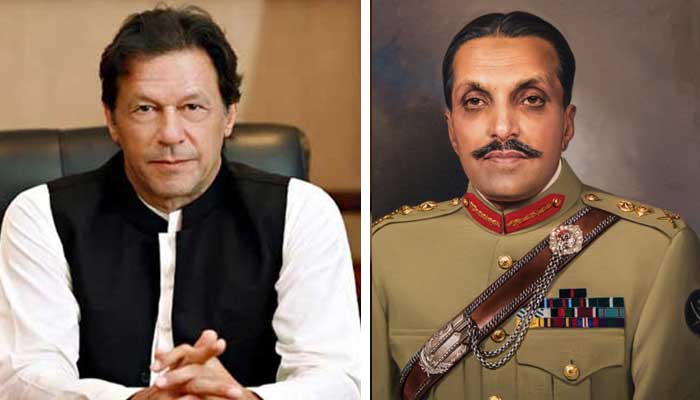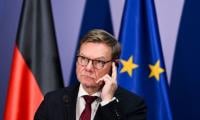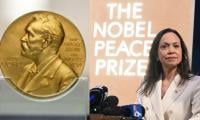PM Khan vs Gen Ziaul Haq
What makes the PTI more interesting than the Zia era however is not the inner recesses of the machine that is driving it – knowingly or unknowingly. What makes the PTI more interesting is that its leader is probably least invested in the Zia era, and only marginally taken by all of its rhetoric.
The big fear in the first half of 2018 was that there would be no election. Somehow, someone, somewhere would find an excuse to delay the election. The conduct of the election, even with the manipulation and engineering that many claim to have been victim of, is a big achievement for the country.
The results of the election were not unexpected. If the Sharifs and the Zardaris could no longer be tolerated by the powerful, a fresh new face with strong support across the country represented an ideal option. The theory was that a strongman in Pakistan with a huge urban base would be able to do a well enough job to steer the country out of the several crises that it faces.
Plenty of the criticism of Prime Minister Imran Khan is fair. But there is a lot of gamesmanship too. The PTI has become a major and, some may argue, dominant political force in the country because Pakistanis have sought change. The driving motivation for the average PTI supporter is reform. Though the exact census data for 2017 has yet to be released, estimates suggest that at least 70 percent of all Pakistanis alive today were born after 1971. This means that very few among voting adults in Pakistan can actually remember what the 1960s were like.
In short, the romance of a well-governed Pakistan is mostly fictional (based on elite recollections, marinated in whiskey and privilege, of how wonderful Ayub Khan’s dictatorship was). The problem this raises is quite complex. But the short version of it is that the whiny depictions of the Ayub era and the freedoms enjoyed by babus and begums at gymkhanas across the country back then is a fraud. For the vast majority of Pakistanis capable of voting and making decisions, the good old days are not the 1960s. The good old days are the 1980s.
This is uncomfortable for many English-medium Pakistanis. The 1980s are supposed to be defined by the darkness of the Zia era repression and excesses that include the skewing of the constitution, the radicalisation of swathes of society, the deliberate stoking of a variety of ethnic conflicts and the suppression of democracy. This is how the dominant English language analysis of Pakistan, especially during the post-9/11 age of terrorism, has mummified the Zia era.
If you look around the reformist government of Imran Khan, however, the truth about the Zia era as it was experienced by city dwellers in Pakistan is beginning to manifest itself vividly and with no apology. For many PTI supporters, and especially for the powerful supporters that Imran Khan banks on, the Zia era is the good old days of Pakistan. A golden era in which Pakistanis were not only respected by the West and by the Arabs, but also a time in which the basis for this respect was Pakistan’s unapologetic support for jihad in Afghanistan, and Pakistan’s open shift to becoming more of a theologically motivated state than it ever was before.
In short, there may be a gap in PM Khan’s idea of reform, and the concept of reform in the imagination of the middle class rank and file of the country. This other concept of reform can be summarised by its three pillars.
First, a more explicit invocation of religion and religiosity in the public domain by the national leadership – a la Ziaul Haq.
Second, a robust set of policy measures to ensure that this invocation of religion is believable – like the claims of introducing Iqbaliyat into the national curriculum – a la Ziaul Haq.
Third, an unapologetic wave of privileging Muslim-identity at the expense of people’s other identities, including linguistic and ethnic identity – like asphyxiating the MQM and denying all oxygen to Pakhtun nationalism – a la Ziaul Haq.
What makes the PTI more interesting than the Zia era however is not the inner recesses of the machine that is driving it – knowingly or unknowingly. What makes the PTI more interesting is that its leader is probably least invested in the Zia era, and only marginally taken by all of its rhetoric.
PM Khan is nothing if not a pragmatic politician. His frequent citation of Madina and of Islamic symbols is instrumental, not essential. He has made this clear in speeches that he gives off the cuff, and without notes, over and over and over again.
In his first address to the nation, PM Khan alluded to malnutrition, child mortality and maternal health constantly. In his speech at the World Government Summit in Dubai, he spoke about China’s adoption of the principals of Madina, as it lifted 700 million people out of poverty. What does all this mean?
It means that PM Khan will happily use Islamic symbols to emphasise the need to reshape the Pakistani state into one that aligns with his vision of compassion and opportunity for those born without the privileges that he has enjoyed in his life. PM Khan is not faking this compassion. He is perhaps the only senior politician in the country with a lifetime record of delivering on this compassion – prior to seeking elected office.
Of course, PM Khan has to deliver this agenda for compassion through the same four instruments that former PM Shaheed Benazir Bhutto or former PM Nawaz Sharif had to. The first is the military that offers this country and its citizens safety and security. The second is the civilian bureaucracy that delivers services to the people, through the management of money and people in the employ of the state. The third is the political elite at the national, provincial and local level whose support one needs to be elected to office and to pass laws. The fourth is the court system, from the magistrate level to the level of Supreme Court justice – whose interpretation of the law is the basis for predictability in our system.
PM Khan’s problem is that the intense compassion he feels for the underprivileged is not shared, at least not as the primary driver of institutional behaviour, among any of these four instruments.
Worse, the higher echelons in all four institutions came of age in the 1980s. Many may have very strong personal intellectual linkages with ideas like pluralism, democracy and federalism (indeed both the current army chief and the current chief justice have a track record demonstrating these intellectual commitments). But the underlying institutional dynamics are not constructed of pluralism, or democracy, or federalism.
The foundations of all four of these vital institutions are monistic, authoritarian, and unitary. The military, the bureaucracy, the political class, and the judiciary are led by men (and sadly too few women) that began adult life in the 1980s. Most attended the various state academies in the early and mid 1980s. By definition, these institutions are conservative and anchored in the status quo. That anchor is 1984: the warm hand of Ronald Reagan petting Pakistan, and the warm feeling of solidarity with a grand Muslim cause in Afghanistan.
PM Khan has a very difficult job. He has to try to resolve technical questions about things like courts, katchehris, judges and policemen for seven new districts in Khyber Pakhtunkhwa, like civil rights for people like Gulalai Ismail and Ammar Ali Jan, like enhancing the quality of nutritional intake by pregnant mothers and newborn children, and like genuine education reform. He must do all this in an economic context in which growth is sputtering and revenue is extremely limited.
But, most difficult of all, he must do so with Pakistan’s key institutions anchored not in a modern vision of a state that protects its weak above all other considerations – like a true Madina-based system. He must do so with Pakistan’s key institutions mired in the institutional lag of a conservative and backward vision of a Pakistan defined, shaped and framed by General Ziaul Haq.
If he seeks confrontation, he will lose. If he seeks accommodation, he will lose. If he seeks equilibrium, he will lose.
How will PM Khan – and the underprivileged women, children and men that he is fighting for – ever win?
The writer is an analyst and commentator.
-
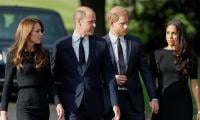 Prince William Takes Bold Move Amid Meghan Markle's Plans To Visit Britain
Prince William Takes Bold Move Amid Meghan Markle's Plans To Visit Britain -
 'Stranger Things' Star Recalls Emotional Last Day On Set
'Stranger Things' Star Recalls Emotional Last Day On Set -
 Briton Smith Stops Matias In Five To Win The WBC Title
Briton Smith Stops Matias In Five To Win The WBC Title -
 Kelly Clarkson Opens Up About Her Kids After Their Dad Passing
Kelly Clarkson Opens Up About Her Kids After Their Dad Passing -
 Google Removes AI Health Summaries After Safety Concerns
Google Removes AI Health Summaries After Safety Concerns -
 Meghan Markle, Prince Harry Warned About Ultimate High-stakes Gamble: 'It's A Bloodbath'
Meghan Markle, Prince Harry Warned About Ultimate High-stakes Gamble: 'It's A Bloodbath' -
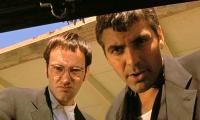 George Clooney Claps Back At Quentin Tarantino For 'cruel' Remarks
George Clooney Claps Back At Quentin Tarantino For 'cruel' Remarks -
 Scientists Discovered Never-before-seen Creature In Great Salt Lake
Scientists Discovered Never-before-seen Creature In Great Salt Lake -
 Three Viruses You Need To Watch Out For In 2026
Three Viruses You Need To Watch Out For In 2026 -
 Musk Says UK Targets Free Speech As X Faces Ban Over Grok AI
Musk Says UK Targets Free Speech As X Faces Ban Over Grok AI -
 'Hunger Games' Star Elle Fanning Reveals Her Goals For 2026
'Hunger Games' Star Elle Fanning Reveals Her Goals For 2026 -
 Zara Tindall Brings Exciting New Year Gift For Royal Family
Zara Tindall Brings Exciting New Year Gift For Royal Family -
 Prince Harry Offering King Charles To Take Part In Invictus Games 2027 Is 'not An Olive Branch'
Prince Harry Offering King Charles To Take Part In Invictus Games 2027 Is 'not An Olive Branch' -
 Inside Prince William's Secret 'war Plan' Against Harry
Inside Prince William's Secret 'war Plan' Against Harry -
 Kidney Damage Is Now Reversible: Here's Where Science Stands
Kidney Damage Is Now Reversible: Here's Where Science Stands -
 Google Maps Begins Rolling Out Redesigned Settings Page
Google Maps Begins Rolling Out Redesigned Settings Page
